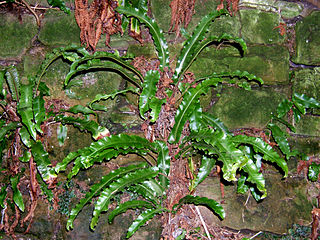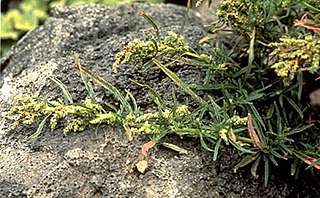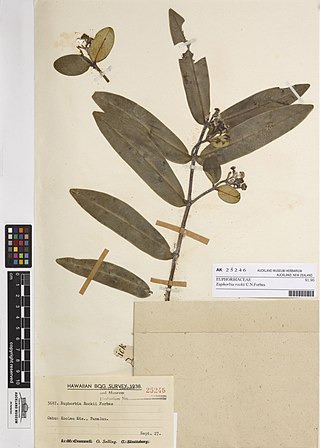
The International Union for Conservation of Nature (IUCN) Red List of Threatened Species, also known as the IUCN Red List or Red Data Book, founded in 1964, is an inventory of the global conservation status and extinction risk of biological species. A series of Regional Red Lists, which assess the risk of extinction to species within a political management unit, are also produced by countries and organizations.

Abutilon menziesii, known as Koʻoloaʻula in Hawaiian, is an endangered species of flowering shrub in the family Malvaceae, that is endemic to Hawaii.

Asplenium scolopendrium, commonly known as the hart's-tongue fern, is an evergreen fern in the family Aspleniaceae native to the Northern Hemisphere.

Marsilea villosa, the ʻihiʻihi (Hawaiian) or villous waterclover (English), is a species of fern that is endemic to the islands of Oʻahu, Molokaʻi and Niʻihau in Hawaii. It is found exclusively in areas that experience periodic flooding and become ephemeral pools within low elevation dry forests and shrublands. Standing water allows the sporocarp to open and release spores. It also enables the resulting sperm to swim toward and fertilize female ova. For new plants to become established, the waters must subside. Sporocarps only form once the soil has dried to a certain level. Like other species in its genus, the leaves of M. villosa resemble those of a four-leaf clover.

Amaranthus brownii was an annual herb in the family Amaranthaceae. The plant was found only on the small island of Nihoa in the Northwestern Hawaiian Islands, growing on rocky outcrops at altitudes of 120–215 m (394–705 ft). It was one of nine species of Amaranthus in the Hawaiian Islands, as well as the only endemic Hawaiian species of the genus. It is now considered extinct.

The Hawaiian hoary bat, also known as ʻōpeʻapeʻa, is a species of bat endemic to the islands of Hawaiʻi. The Hawaiian hoary bat occupies the major Hawaiian islands, making it the only extant and native terrestrial mammal in the islands. Some studies report that the mainland hoary bat lives in sympatry on the Hawaiian Islands alongside the Hawaiian hoary bat, although this is disputed. The Hawaiian hoary bat was officially named the state land mammal of Hawaiʻi in 2015. It is a federally listed endangered taxon of the United States.

A species that is extinct in the wild (EW) is one that has been categorized by the International Union for Conservation of Nature as only consisting of living members kept in captivity or as a naturalized population outside its historic range. Classification requires exhaustive surveys conducted within the species' known habitat with consideration given to seasonality, time of day, and life cycle. Once a species is classified as EW, the only way for it to be downgraded is through reintroduction.

Ctenitis is a fern genus in the family Dryopteridaceae, subfamily Dryopteridoideae, in the Pteridophyte Phylogeny Group classification of 2016.

Adenophorus periens is a rare species of fern known by the common name pendant kihi fern. It is endemic to Hawaii, where it is known from one population in Puna on the island of Hawaii and a few occurrences on Kauai and Molokai. The fern occurs in wet mountain forests on volcanic slopes. It grows on trees. There are perhaps 2000 individual plants remaining. This is a federally listed endangered species of the United States.
Euphorbia deppeana is a rare species of flowering plant in the family Euphorbiaceae known by the common names Deppe's broomspurge and Oahu sandmat. It is endemic to Oʻahu, Hawaii, where it is known from only one population in moist shrublands on Nuʻuanu Pali. Like other native Hawaiian euphorbs it is called ʻakoko locally.

Euphorbia rockii is a rare species of flowering plant in the euphorb family known by the common names Koolau Range sandmat and Rock's broomspurge. It is endemic to Oʻahu, Hawaii, where it is known only from the Koʻolau Mountains. There are 200 to 300 plants remaining. Like other Hawaiian euphorbs, this plant is known locally as ʻakoko.

Cyanea asarifolia is a rare species of flowering plant in the bellflower family known by the common name gingerleaf cyanea. It is endemic to Kauai, where there were no more than 30 individuals in a single population as of 2005. It is a federally listed endangered species of the United States. Like other Cyanea it is known as haha in Hawaiian.
Cyanea copelandii is a rare species of flowering plant in the bellflower family known by the common name treetrunk cyanea. It is endemic to Maui, where there are no more than 250 individuals remaining in the wild. It is a federally listed endangered species of the United States. Like other Cyanea it is known as hāhā in Hawaiian.
Cyanea glabra is a rare species of flowering plant in the family Campanulaceae known by the common name smooth cyanea. It is endemic to Maui, where there are twelve plants remaining in the wild. It was federally listed as an endangered species of the United States with nine other Maui Nui endemics in 1999. Like other Cyanea it is known as haha in Hawaiian.

Cyanea hamatiflora is a rare species of flowering plant in the bellflower family known by the common name wetforest cyanea. It is endemic to Hawaii, where it is known from the islands of Maui and Hawaii, and there are probably fewer than 250 plants remaining in total. It is a federally listed endangered species. Like other Cyanea it is known as haha in Hawaiian.
Cyrtandra polyantha is a rare species of flowering plant in the African violet family known by the common names Niu Valley cyrtandra. It is endemic to the Hawaii, where it is known only from the Koʻolau Mountains of Oahu. In 2007 there were only two populations containing a total of 46 mature plants, but one of the two populations is made up of a single individual. It was federally listed as an endangered species in 1994. Like other Hawaiian Cyrtandra it is called ha`iwale.

Doryopteris angelica is a rare fern species, known by the common name Kauai digit fern. It is endemic to Hawaii where only small populations are known.
Ctenitis pallatangana is a species of fern. The only known collection was made more than a century ago, near Pallatanga in Chimborazo province, Ecuador, in high Andean forest above 1 500 m altitude. Lack of any further collections and widespread destruction of its habitat has resulted in it being listed by the IUCN as "Critically Endangered ". The main threat to the species is believed to be habitat destruction by agricultural expansion.
Cyanea gibsonii is a species of flowering plant in the family Campanulaceae that was first described by William Hillebrand. It is endemic to the island of Lanai, Hawaii, United States.
Asplenium dielfalcatum is a species of fern in the family Aspleniaceae. It is native to Oahu, Hawaii.













